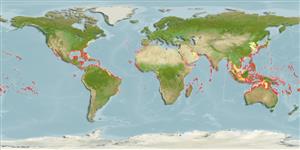Common names from other countries
>
Lophiiformes (Anglerfishes) >
Antennariidae (Frogfishes)
Etymology: Histrio: Latin, histrionicus = related with actors; because of the movements of that mekaes this fish before catching its preys (Ref. 45335).
More on author: Linnaeus.
Environment: milieu / climate zone / depth range / distribution range
Ecologia
marinhas associadas(os) a recifes; oceanódromo (Ref. 51243); intervalo de profundidade 0 - 50 m (Ref. 58302), usually 0 - 2 m (Ref. 58302). Subtropical; 46°N - 36°S, -180°W - 180°E
Indian Ocean: tip of South Africa eastward to Indian and Sri Lanka, including the Red Sea, Madagascar, Réunion and Mauritius. Western Pacific: Hokkaido to tropical Australia (as far south as Perth in the west and Sydney in the east), including Taiwan, Philippines, Moluccas, southern Papua New Guinea, Guam, Tonga, New Caledonia and New Zealand; Mariana Islands in Micronesia (Ref. 1602). Occurrence in the eastern Pacific remains problematic. Northwest Atlantic: Canada (Ref. 5951). Western Atlantic: Gulf of Maine to the mouth of the Rio de la Plata, Uruguay. Eastern Atlantic: Azores and off West Africa; record from Vardø, northern Norway (Düben & Koren 1846) is based on a straggler taken northward by the North Atlantic and Norwegian currents.
Tamanho / Peso / Idade
Maturity: Lm ? range ? - ? cm
Max length : 20.0 cm TL macho/indeterminado; (Ref. 7251)
Descrição breve
Chaves de identificação | Morfologia | Morfometria
Espinhos dorsais (total) : 3; Raios dorsais moles (total) : 11 - 13; Espinhos anais: 0; Raios anais moles: 6 - 13. Diagnosis: body short and globose; mouth large with many small, villiform teeth; skin naked, but head, body and fins covered with numerous skin flaps; very long pelvic fins (> 25% SL); unprotected illicium or lure attains less than half of second dorsal-fin spine and 4.5-9.3% of SL (Ref. 57225).
Found near the surface, usually associated with floating objects (Ref. 26340) or Sargassum. Found near shore and occasionally among floating seaweeds (Ref. 57225). Commonly blown into shore and bay waters during storms (Ref. 7251). Epipelagic (Ref. 58302). A solitary (Ref. 26340) and voracious predator (Ref. 5521). They feed on fishes and shrimps that seek refuge in the floating weeds (Ref. 48635). Oviparous. Eggs are bound in ribbon-like sheath or mass of gelatinous mucus called 'egg raft' or 'veil' (Ref. 6773, 48635). Solitary or loose groups among floating seaweed (Ref 90102).
Life cycle and mating behavior
Maturities | Reprodução | Spawnings | Egg(s) | Fecundities | Larvas
Oviparous. During courtship, the male follows the female closely then both rush to the surface to spawn (Ref. 205). At this point, eggs are produced in a gelatinous floating mass or 'raft' and inseminated by the male. The eggs remain embedded in this raft until hatching (Ref. 240).
Pietsch, T.W. and D.B. Grobecker, 1987. Frogfishes of the world. Systematics, zoogeography, and behavioral ecology. Stanford University Press, Stanford, California. 420 p. (Ref. 6773)
Categoria na Lista Vermelha da IUCN (Ref. 130435)
CITES (Ref. 128078)
Not Evaluated
Ameaça para o homem
Reports of ciguatera poisoning (Ref. 30911)
Utilização humana
Pescarias: pescarias de subsistência; Aquário: Espécies comerciais
Ferramentas
Relatórios especiais
Descarregue XML
Fontes da internet
Estimates based on models
Preferred temperature (Ref.
115969): 21.4 - 29.2, mean 27.7 (based on 4840 cells).
Phylogenetic diversity index (Ref.
82804): PD
50 = 1.0000 [Uniqueness, from 0.5 = low to 2.0 = high].
Bayesian length-weight: a=0.01995 (0.00906 - 0.04395), b=3.01 (2.83 - 3.19), in cm Total Length, based on all LWR estimates for this body shape (Ref.
93245).
Nível Trófico (Ref.
69278): 3.9 ±0.63 se; based on food items.
Resiliência (Ref.
120179): Elevada, tempo mínimo de duplicação da população menor que 15 meses (Fec assumed to be > 10,000).
Fishing Vulnerability (Ref.
59153): Low vulnerability (10 of 100).
